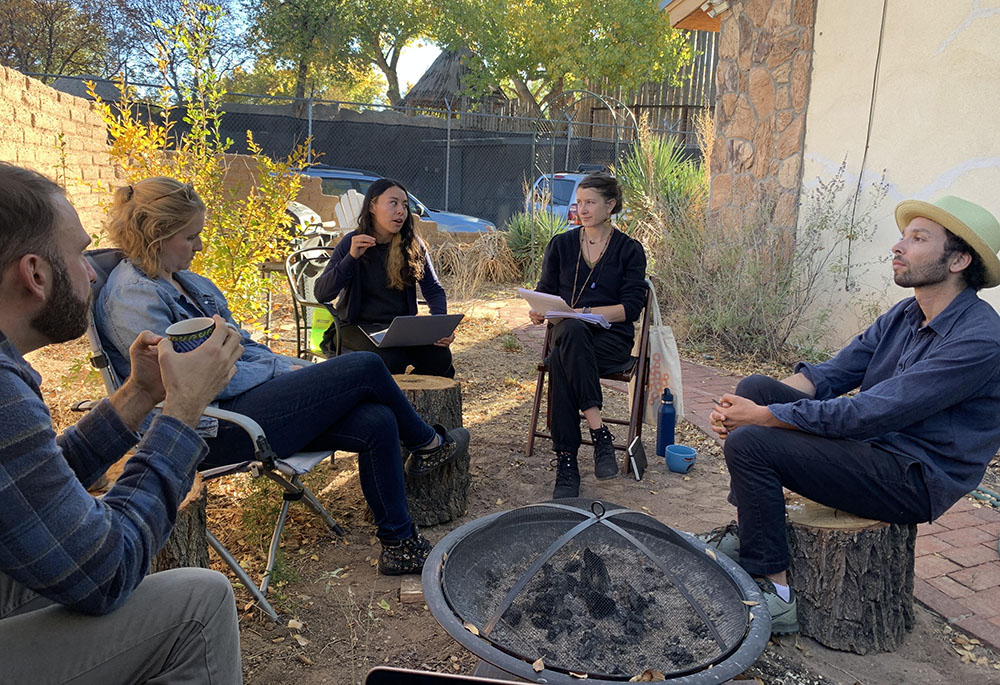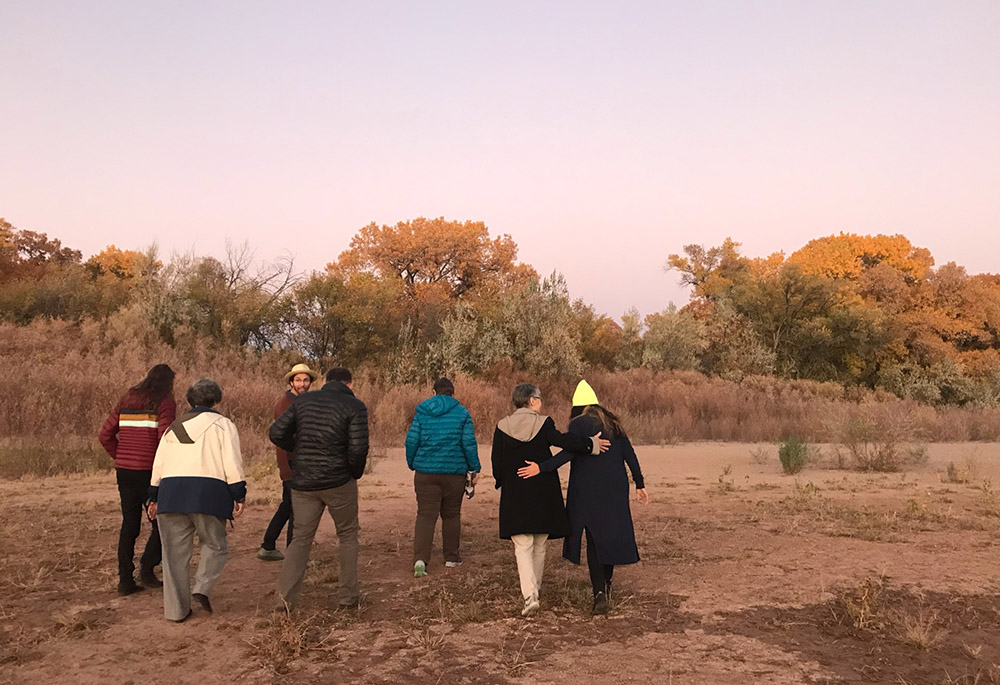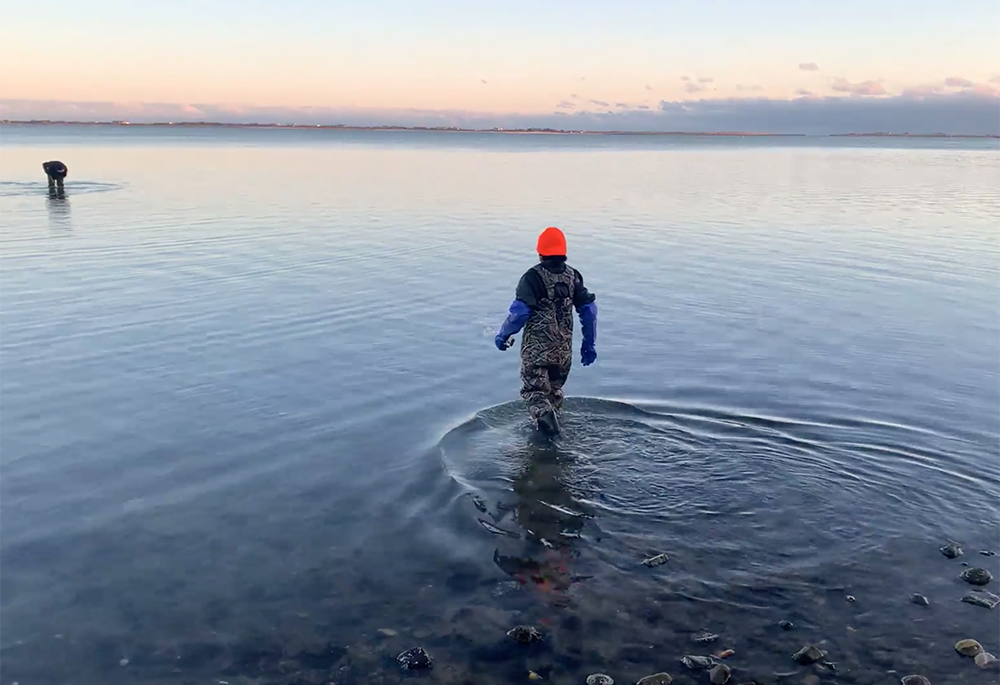
Land Justice team members Sarah Bradley and Diana Marin lead a group discussion on decolonization in Albuquerque, New Mexico. (Courtesy of Brittany Koteles)*
Many Catholic sisters throughout the United States now find themselves akin to empty nesters in outsized homes, their estates too big and demanding for their needs.
But selling and downsizing isn't the only option available to women religious, as the Nuns and Nones Land Justice Project aims to demonstrate: The properties belonging to sisters are opportunities for them to reimagine and utilize the future of their land in a creative manner in line with their charism or penchant for climate and racial justice.
Through the Land Justice Project, which concludes its inaugural eight-week course next week (April 28), sisters have been learning how to create new land legacies that center racial and ecological healing. With land experts, Indigenous leaders, and environmentalists as presenters, the course is also a form of networking to empower participants with resources and relationships as they begin to experiment with their property planning.
The course is just the beginning. After participants are exposed to different approaches to explore with their properties — going beyond conservation and, for example, bringing marginalized farmers into land tenure or ownership — the land justice team will serve as an ongoing resource to help bring the congregation's vision to fruition.

Sarah Bradley, who leads the Land Justice Project's strategies and partnerships (Courtesy of Sarah Bradley)
Because sisters, they believe, are the ideal candidates to revolutionize land access.
"They have an embodied history of making countercultural choices, of taking risks for a cause, of loving the world into its more just future," said Sarah Bradley, who leads the Land Justice Project's strategies and partnerships. "They have a history of creating new systems, and they have a history of really taking a stand from a place of their spiritual formation and deep discernment."
They also have structures of collective governance that allow them to make choices on a larger scale than individual landowners, she added.
For example, the Sinsinawa Dominicans own a massive campus and 400 acres of prime agricultural real estate in Wisconsin. Dominican Sr. Quincy Howard, who is taking the Land Justice Project's course and is part of her community's team that handles land conservation and property planning, said the Sinsinawa Dominicans have been discerning next steps — including negotiating a land trust — regarding their assets while keeping it in line with one of the congregation's missions.
"Healing relationships, whether that's between people or the Earth, is a core characteristic of women religious," Howard said.
"It only makes sense to see what the Nuns and Nones group is putting out there, helping us be aware of the different initiatives and approaches to land conservation as I move into that space."

(GSR graphic/Soli Salgado)
Howard's background in urban planning and community development equipped her to think about problems around conserving land or preventing development even before she participated in the Land Justice Project.
"We are moving into a new paradigm, but we don't understand how to hold those tools lightly and make sure that they don't become barriers to future visions," Howard said.
The conservation easement her congregation is currently negotiating, for example, would attempt to prevent potential development pressure in the future, such as industrial farming operations. But "we also don't want it to be unduly restrictive on uses that would be unforeseen to us because we can't get a clear read on what the future is going to bring."
The Land Justice Project, she said, has given her a new lens to frame her work in her congregation, as well as an appreciation for being flexible while "moving into the unknown."
"Part of our mission is to find a better way to move into the future, to bring about a new creation that involves healing all of these systems ... in a way that is more aligned with the Gospel call."

(GSR graphic/Soli Salgado)
Nuns and Nones aims to fill a gap
For the past five years, the growing Nuns and Nones movement has brought together Catholic sisters and young spiritual seekers in small-group dialogues throughout the country, bonding over their mutual interest in contemplation, community life and social justice.
But after spending time listening to sisters, Bradley and Brittany Koteles, both founding members of Nuns and Nones, said they sensed a gap between where the climate justice movement is heading and the conversations they heard around religious property planning.
"The people who are best positioned to model a healed relationship with the Earth" — Indigenous people and other regenerative stewards — "are oftentimes the least likely to be able to do it because they can't access it," Koteles said.
"We need to build pathways to land equity, land tenure and land stewardship for those groups of people."

(GSR graphic/Soli Salgado)
Just as sisters have been bringing on more lay leaders and partners into their ministries in response to declining membership, she said, "the same can be true about the way they're thinking about their properties."
Koteles, who is the director of the Nuns and Nones Land Justice Project, said the group discerned this disconnect for more than a year because "we still weren't sure whether it was our place to be bringing up those kinds of decisions."
"We wanted to be clear on, if we're going to do this work, why us?" she said. "Nuns and Nones has always been about building bridges between unlikely allies, and this is a bridge that we really want to build ... between the sisters having conversations about the future of their properties and the local front-line groups regenerating land and creating local climate resilience and pursuing racial healing."
While sisters were largely familiar with the option of conservation easements, for example, the Land Justice Project explores more collaborative alternatives that are fairly foreign to their communities, such as long-term leases to local farmers or selling below market value.
"Once that was more apparent, we started hearing [from the sisters], 'This is needed, this is different, this is really energizing,' " Koteles said.

The Nuns and Nones team on the Rio Grande, October 2021 (Courtesy of Brittany Koteles)
The Nuns and Nones land justice team has spent much of the pandemic learning about just transition and researching and engaging with a spectrum of movements — those in faith-based land justice, reparations, solidarity economy, climate justice and more — as they aimed to close the gap between those organizing around the issues and those who hold titles to land, Bradley said.
The first online course, which started March 10 and ends April 28, drew 600 participants. About two-thirds are sisters (100 of whom are in leadership), and the other third includes community staff and associates as well as those involved in congregational property planning. Recordings of the sessions are available here, with ongoing educational resources to come.
The timing of this effort coincides with the work of the Leadership Conference of Women Religious, which represents 80% of U.S. Catholic sisters: The conference's 2019-2022 resolution aims to create "communion at the intersection of racism, migration & climate crisis."
"It feels like this is what time it is on the clock of the world," Bradley said.
And because sisters are already attuned to thinking holistically about the land as a web of relationships, rather than as mere capital, Koteles said, "we're not starting from zero."

The New York City Nuns and Nones group tours the Shinnecock Kelp Farmers farm, in Hamptons Bay, New York, on the St. Joseph Sisters' property. The ongoing Shinnecock-St. Joseph of Brentwood partnership was the first case study that the Land Justice Project presented in its inaugural eight-week course. (Courtesy of Brittany Koteles)*
'A micro form of repatriation'
The St. Joseph Sisters of Brentwood, New York, have always been neighbors with the sovereign Shinnecock Indian Nation, one of 13 tribes on Long Island before European colonization.
The friendly acquaintance blossomed into a relationship, however, when members of the Shinnecock and Unkechaug tribes approached the Brentwood campus a couple of years ago, hoping to bury their ancestral bones in a sacred spot that was part of the sisters' cemetery. Sr. Joan Gallagher said her community was invited into the ritual and celebratory meal that followed, cementing the friendship and encouraging the sisters to learn more about the tribe.
The ongoing Shinnecock-St. Joseph of Brentwood partnership was the first case study that the Land Justice Project presented in its course, an example of the possibility lurking in a community's literal backyard and how pursuing land justice doesn't need to be complicated from the outset.
Advertisement
More recently, one of the Shinnecock leaders contacted Gallagher in January 2021 about accessing the congregation's waters in Hampton Bays so they could launch a kelp farming project.
Gallagher told her fellow sisters, "How can we not? They walked this land before our coming here."
They created an incubation space for kelp seeds in a cottage on the sisters' property, and since then, the kelp has grown and been harvested, dried, and sold to farmers as fertilizer. The next harvest will be in late April.
"If those farmers can then use this kelp that was grown in the Shinnecock Bay and harvested by the Shinnecock farmers, it's just a beautiful relationship," said Gallagher, adding that kelp will help purify the bay and attract shellfish for the tribe to eat.

Danielle Munnannock Hopson Begun and Toby Sheppard Bloch wade into the Shinnecock Bay to weed underwater kelp lines. (Courtesy of Brittany Koteles)
"We made it clear from the get-go that yes, they can most definitely have access to the bay, and we will do whatever kind of support they need," she said. "But it is their project, it is their name, and it is their profit for their own economy. We're not looking to skim anything off what they reap. ... It's a micro form of repatriation, if you will."
Learning about the needs of a local Indigenous community or a regenerative farmer and offering access to community property can be just the start, Bradley said. Over time, that relationship could develop into a variety of options: The group or farmer could buy a portion of the land, or maybe the entire land is conserved, with some set aside to grow food for food security projects, Bradley said.
The Land Justice Project is eager to help sisters find these local connections.
"The bottom line is, there lots of options, and it's more like you're a painter with an array of colors and paints that you can work with [rather] than there being a formula or flow chart to go through," she said.
"We're leaning on our partners to really show what some of those color palettes are and what we can make."

(GSR photo/Soli Salgado)
Dispelling the myth of private land
Given the amount of land Catholic sisters and other religious communities possess, they have the power to "shift the reality" of land ownership, which has been increasingly consolidated since the start of colonization and privatization, said Ian McSweeney, director of Agrarian Trust.
Agrarian Trust is a nonprofit that supports land access for "the next generations of farmers" and created the FaithLands Toolkit that is guiding the Land Justice Project. An initiative under Agrarian Trust, FaithLands is "an emerging coalition and learning community seeking to connect religious traditions, agriculture, and ecological stewardship, inspiring a spiritual and ethical revolution in our relationship to each other and the land," according to the website.
McSweeney said the organization will also be an ongoing resource for those experimenting in land justice and access following the course.
"We're so disconnected from land," McSweeney said. "People don't think about power they have with land — to own land, donate land, sell land, buy land."

Ian McSweeney, director of Agrarian Trust (Courtesy of Ian McSweeney)
For most religious organizations, the distant generation that purchased or acquired the land never had to think about selling it, he said.
Putting land into the hands of those who grow food for their communities or those who have been historically sidelined from ownership could have limitless positive side effects, McSweeney said: revitalized soil, improved health for those living off the land, and local economic opportunities for the communities.
"It could have a significant impact," he said.
Through his work with the FaithLands movement, McSweeney found that many faith communities don't even know what land they own. But after trading this disconnect for awareness, he said, moving forward can be simple; all that's needed is an attorney and a deed to transfer property, if that's the decision.
Koteles said the more these possibilities are discussed, the more possible they become.
"It's about changing the whole story about who we are and to whom we are responsible, telling stories of healing and love over empire and extraction," she said. "And I don't know anyone more equipped to tell that story than the sisters I've met along the way."
*This story has been updated to correct two cutlines.






